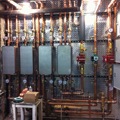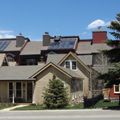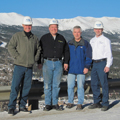Creative solar thermal installation generates savings at Colorado housing complex.

Residents of a condominium complex in the ski resort town of Breckenridge, Colo., are getting their money’s worth and then some thanks to the installation of an innovative solar thermal system.
Local solar guru Bob Kingston, of RE-Align Technology, was brought in by Mark Stearns of Mech Tech, the project mechanical contractor. The team was rounded out by Sunshine Solar and Mechanical’s William Frew and Alpine Heating Services’ Lumir Pajaj to design, fabricate and install in the 60-unit Long Branch Condominiums a solar thermal system that satisfies residents’ domestic hot water needs while also providing heat to the indoor spa, pool and sauna. More importantly, the new system has shaved money off residents’ energy bills and generated a government tax rebate for each one.
The team installed 28 SolarHot collectors on the three-story roof spread across nine arrays for optimal snow shedding (Breckenridge received 500 inches of snow last winter). “Twenty-eight and nine are not divisible into each other,” Kingston says with a laugh. “We really had to balance the arrays and the flows.” The aging spa and pool gas-fired heaters were removed and a 1,400-gallon solar storage tank (with 4 in. of polystyrene insulation skinned with diamond plating) was added along with five oversized flat-plate heat exchangers and two titanium pool/spa heat exchangers.
“On the way to financial justification with this project, the complex’s boilers for the pool and spa hit end of life,” states Kingston, who holds a degree in nuclear engineering. “We needed to have a place to dump heat and the pool and spa were ideal locations. We teamed the solar with their central boilers and that’s how the pool and spa are now heated. It saved them from having to replace those two boilers.” An 80-gallon recovery tank recovers glycol in case the power goes out and the system overheats.

Location is everything
The installation had to overcome a pair of logistical roadblocks, one internally and one outside the complex. Kingston explains the complex’s mechanical room, where domestic hot water is the focus of the solar heat, is located in one corner of the building, while the pool and spa sit in the other corner. “It’s a good-sized building,” he notes. “We took the collector runs down to the mechanical area and also used the underground garage to communicate all the way to the pool and spa. The system was set up as a primary-secondary circulation.”
The team also had to be mindful of local Breckenridge aesthetic regulations regarding the look of the external collectors.
“It’s on the edge of Breckenridge’s historic district,” Kingston points out. “That meant we needed to make it fit within how Breckenridge wanted to see the community. Bobby Craig (owner/architect of Arapahoe Architects) ensured the design fit within the aesthetic needs of Breckenridge. The collectors are all flush-mount. The second concern was because it is Breckenridge and it does snow an awful lot sometimes; we wanted to make sure the collectors would be able to shed snow. We picked locations where they easily could shed below. The challenge of one doorway access was overcome by good collector placement.”
Gap covers and gap seals were designed to plug the gaps between collectors. “You can’t even see them. It fills in the spots and still allows the snow to shed,” Stearns notes.
The team also focused on how the system would look in the 40-year-old mechanical room.
“Something like this hasn’t been done, especially with the neatness,” Frew says. “Mark insisted on a diamond plate metal exterior to the solar tank. While ruggedizing the solar tank, it also makes it jump out at you. Any time anybody comes in and takes a look at the system they say: `Wow! This is a work of art.”

Playing the seasons
With Breckenridge being a resort town, system demand at the complex greatly varies depending on what the calendar reads.
“There are big seasonal variations on the load,” Stearns says. “It’s heavy in the winter and heavy in the summer and in the mid-shoulder season, it could be fairly quiet. At this time of year (winter), everything is going into the domestic hot water. That water is coming in at 35°F, so there is a lot of heating to be done before it gets to the condos. In April and May when there is a very strong solar performance, the domestic hot water needs are met and the system has to automatically redirect loads to the other end of the building. We really focused on the control strategy so we could shift excess loads once the need for domestic hot water was met.”
The group went up a size in heat exchangers in order to ensure maximum system efficiency.
“On the incoming water side from the town, we’re seeing cold water get boosted to within 10°F of whatever the solar tank temperature is,” Kingston notes. “If the tank is up there and is pretty hot, it means the entire domestic system is fully charged. We’re very pleased that we went to the next step with the heat exchangers. On a solar system, larger heat exchangers are well worth it. They are a lot more efficient.”
Incoming water is directed to the heat exchanger in the solar tank and then hits the first conventional domestic hot water tank and goes onto the second tank before being distributed to the building.
“We’ve synched it with domestic hot water recirculation. Just by making sure we’re bringing the building recirc up to temperature, we’re probably saving a lot of energy right there,” Papaj notes.
Watts advanced controllers interface with external relays where there is a need to drive a larger pump, a higher electrical load or to sync with the boiler.
“We’re providing a very powerful and consistent delivery of domestic hot water throughout the night and a good heating balance during the day,” Stearns states.
Savings time
The entire system carried a $105,000 price tag. However, Frew points out each resident received a $500 federal tax credit (based off the 30% federal tax credit the complex received). The system continues to draw rave reviews from both property management and residents alike.
“To do a project such as this in the High Country is huge. It hasn’t been done before,” states Frew, who adds the team is expanding to partner with installers and their customers nationwide. “It was an exciting project. It’s over-performing. Monthly bills are a lot cheaper.”
